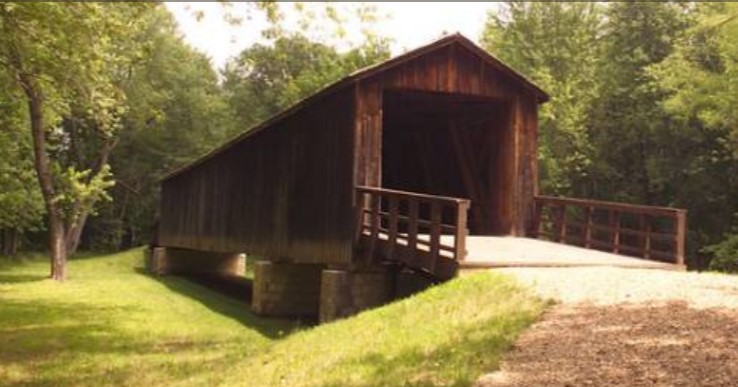The Locust Creek Covered Bridge State Historic Site just outside of Meadville is now closed to the public as of Dec. 24 at noon. This comes as preparations begin to move the historic bridge to Pershing State Park. The relocation is part of an effort to preserve one of Missouri’s last four remaining covered bridges. The closures are necessary to facilitate the upcoming move and ensure public safety during the process.
Originally constructed to span Locust Creek on Route 8, America’s first transcontinental road, the bridge played a vital role in the early 20th century. However, as cars replaced horse-drawn vehicles, Route 8 was replaced by U.S. Highway 36 in 1930, and the bridge fell out of use. Over time, Locust Creek’s channel was straightened, leaving the bridge spanning a dry creek bed.
The current location of the bridge has left it vulnerable to damage from an unstable watershed, prompting the decision to relocate it to Pershing State Park. The move will restore the bridge’s historical context by placing it over water once again.
The relocation is scheduled for late January or early February 2025, depending on weather conditions. Pershing State Park, located at 29277 Highway 130 in Laclede, Missouri, will become the new home for this important piece of Missouri history.
Meadville has long been home to this historic site and a place where many came to take pictures and awe in the site of the history. For decades, visitors even left their initials carved or written within the walls of the bridge.
The Meadville community still has the covered bridge on the city welcoming sign located at the Junction of Highway 36 and 139. In an effort to try to conserve the location to stay in Meadville, community members tried to donate land and organize methods to attempt to prevent the removal from the area of Meadville but to maintain its preservation. It couldn’t get pulled off.
“The Meadville Betterment Association tried to get it moved to Meadville, did a lot of work, had a plan to put it north of town on a piece of property, but they wanted it on actual park property I guess,” said resident, Marc Zell.
While many residents understand the need for updates, the community is also saddened and upset that there wasn’t a viable option to keep the covered bridge in Meadville. It has been determined that because of natures course, this is the most viable way to salvage the structure.
“Sad it’s moving, yes. Is it for the greater good? Probably. Is it moving that far? No, it’s not,” said Nathan Raymo, a Meadville resident. “Meadville can still be the home of the Locust Creek Covered Bridge. It will be a couple miles from current location in a more accessible area for people of all ages. Those bridge walls have a ton of history carved into them. I just ask those walls be preserved.”
Nearby resident, Peggy Farmer, has been on the hunt with more questions.
Farmer inquired about at least getting signage that acknowledged the structure as ‘Meadville Covered Bridge’ or something similar. The response: “I’m not sure about installing a sign, it will still be Locust Creek Covered Bridge State Historic Site. If Meadville wants to sponsor a memorial bench down by the bridge, it could have a plaque attached that says Meadville’s Bridge and it would get a lot of use,” according to a Missouri Parks representative. The expense of a bench is up in the air.
Others passionate about the project chimed in. Some agree it is a good move because its current location keeps the structure at risk. In the case a If wildfire should start, the bridge might be gone before anyone knows of it. Vandalism is also a concern and with the relocation to Pershing Park, the bridge may be better protected and monitored. Though there are concerns about the new-to-come placement.
“I worked for DNR in the early 90’s and they wanted to move it even then, however they decided to update the access to it provide what is currently there,” said Cindy Montague of Laclede. “There was a public meeting last summer some time where this was discussed with anyone who attended and they also discussed the future of the Pershing Home. I know one of the big issues that has caused the desire to move it, in addition to saving the bridge itself, is when it is wet and they have to close access to the bridge that reduces the number of visitors that can see the bridge.” Montague said she saw the advantage of moving it to Pershing Park.
“It will be back over Locust Creek and will be accessible to more people because it is such a treasure for the state,” she said. “I personally hate to see it moved because I remember going there as a kid and how exciting it was to go visit it, but looking at the big picture, it is best for the bridge and the most cost effective way of using our tax dollars.”
Meadville residents simply hate to lose the sentiment of the structure being located within the Meadville area.
For additional details about the move, contact Pershing State Park at 660-963-2299. To learn more about Missouri’s state parks and historic sites, visit mostateparks.com. Missouri State Parks is a division of the Missouri Department of Natural Resources.



